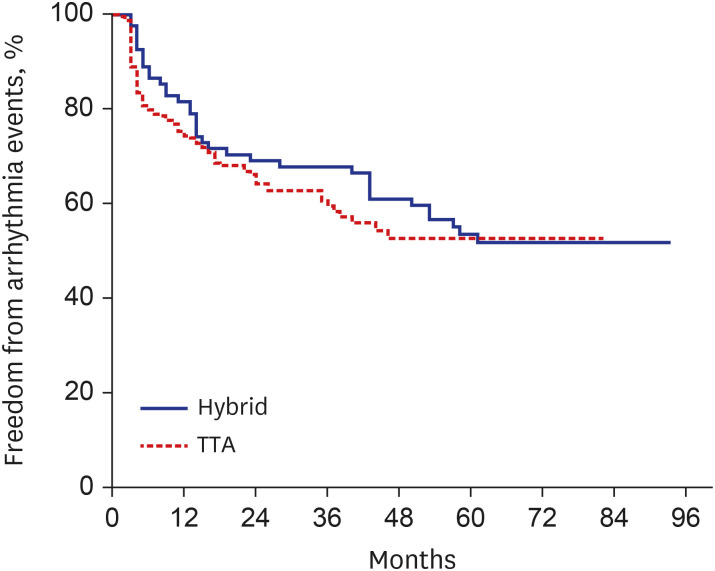J Korean Med Sci.
2021 Nov;36(43):e276. 10.3346/jkms.2021.36.e276.
Effectiveness of the Early Staged Hybrid Approach for Treatment of Symptomatic Atrial Fibrillation: the Electrophysiology Study Could Be Deferred?
- Affiliations
-
- 1Division of Cardiology, Department of Internal Medicine, Heart Vascular and Stroke Institute, Samsung Medical Center, Sungkyunkwan University School of Medicine, Seoul, Korea
- 2Department of Thoracic and Cardiovascular Surgery, Samsung Medical Center, Sungkyunkwan University School of Medicine, Seoul, Korea
- 3Division of Cardiology, Department of Internal Medicine, Chungnam National University Hospital, Chungnam National University School of Medicine, Daejeon, Korea
- KMID: 2522287
- DOI: http://doi.org/10.3346/jkms.2021.36.e276
Abstract
- Background
The efficacy of catheter ablation for persistent atrial fibrillation (AF) remains suboptimal. A hybrid approach of catheter ablation combined with totally thoracoscopic surgical ablation can improve outcomes. In this study, we evaluated the efficacy of the early staged hybrid procedure in hospital stay after totally thoracoscopic ablation compared to the stand-alone totally thoracoscopic ablation.
Methods
Patients who underwent totally thoracoscopic ablation from February 2012 to December 2018 were included in this study. We compared the outcomes of the totally thoracoscopic ablation only group versus the early staged hybrid procedure group. The primary outcome was recurrence of atrial tachyarrhythmia after three months of blanking period. The secondary outcome was repeated unplanned additional electrophysiology study and catheter ablation due to atrial tachyarrhythmia recurrence.
Results
A total of 306 patients (mean age, 56.8 ± 8.5 years; 278 [90.8%] males) was included in the study, with 81 patients in the early staged hybrid group and 225 patients in the standalone totally thoracoscopic ablation only group. The mean follow-up duration was 30.0 months. Overall arrhythmia-free survival showed no significant difference between the two groups (log-rank P = 0.402). There was no significant difference in the rate of repeat procedure between the two groups (log-rank = 0.11).
Conclusion
The early staged hybrid procedure after thoracoscopic ablation could not improve the outcome of recurrence of atrial tachyarrhythmia. The second stage of electrophysiology study could be deferred to patients with recurrence of atrial tachyarrhythmia during follow up after totally thoracoscopic ablation.
Keyword
Figure
Reference
-
1. Anter E, Jessup M, Callans DJ. Atrial fibrillation and heart failure: treatment considerations for a dual epidemic. Circulation. 2009; 119(18):2516–2525. PMID: 19433768.2. Dries DL, Exner DV, Gersh BJ, Domanski MJ, Waclawiw MA, Stevenson LW. Atrial fibrillation is associated with an increased risk for mortality and heart failure progression in patients with asymptomatic and symptomatic left ventricular systolic dysfunction: a retrospective analysis of the SOLVD trials. J Am Coll Cardiol. 1998; 32(3):695–703. PMID: 9741514.
Article3. Haïssaguerre M, Jaïs P, Shah DC, Takahashi A, Hocini M, Quiniou G, et al. Spontaneous initiation of atrial fibrillation by ectopic beats originating in the pulmonary veins. N Engl J Med. 1998; 339(10):659–666. PMID: 9725923.
Article4. Marrouche NF, Brachmann J, Andresen D, Siebels J, Boersma L, Jordaens L, et al. Catheter ablation for atrial fibrillation with heart failure. N Engl J Med. 2018; 378(5):417–427. PMID: 29385358.
Article5. Verma A, Jiang CY, Betts TR, Chen J, Deisenhofer I, Mantovan R, et al. Approaches to catheter ablation for persistent atrial fibrillation. N Engl J Med. 2015; 372(19):1812–1822. PMID: 25946280.
Article6. Nery PB, Thornhill R, Nair GM, Pena E, Redpath CJ. Scar-based catheter ablation for persistent atrial fibrillation. Curr Opin Cardiol. 2017; 32(1):1–9. PMID: 27875475.
Article7. Suwalski P, Kowalewski M, Jasiński M, Staromłyński J, Zembala M, Widenka K, et al. Survival after surgical ablation for atrial fibrillation in mitral valve surgery: Analysis from the Polish National Registry of Cardiac Surgery Procedures (KROK). J Thorac Cardiovasc Surg. 2019; 157(3):1007–1018.e4. PMID: 30314688.8. Gillinov AM, Gelijns AC, Parides MK, DeRose JJ Jr, Moskowitz AJ, Voisine P, et al. Surgical ablation of atrial fibrillation during mitral-valve surgery. N Engl J Med. 2015; 372(15):1399–1409. PMID: 25853744.
Article9. Pyo W, Park SJ, Kim WK, Kim HJ, Kim JB, Jung SH, et al. Surgical ablation of atrial fibrillation in patients undergoing bioprosthetic valve replacement. Korean J Thorac Cardiovasc Surg. 2019; 52(2):61–69. PMID: 31089442.
Article10. Hindricks G, Potpara T, Dagres N, Arbelo E, Bax JJ, Blomström-Lundqvist C, et al. 2020 ESC Guidelines for the diagnosis and management of atrial fibrillation developed in collaboration with the European Association for Cardio-Thoracic Surgery (EACTS): The Task Force for the diagnosis and management of atrial fibrillation of the European Society of Cardiology (ESC) Developed with the special contribution of the European Heart Rhythm Association (EHRA) of the ESC. Eur Heart J. 2021; 42(5):373–498. PMID: 32860505.11. Phan K, Phan S, Thiagalingam A, Medi C, Yan TD. Thoracoscopic surgical ablation versus catheter ablation for atrial fibrillation. Eur J Cardiothorac Surg. 2016; 49(4):1044–1051. PMID: 26003961.
Article12. On YK, Park KM, Jeong DS, Park PW, Lee YT, Park SJ, et al. Electrophysiologic results after thoracoscopic ablation for chronic atrial fibrillation. Ann Thorac Surg. 2015; 100(5):1595–1602. PMID: 26215779.
Article13. Choi MS, On YK, Jeong DS, Park KM, Park SJ, Kim JS, et al. Usefulness of postprocedural electrophysiological confirmation upon totally thoracoscopic ablation in persistent atrial fibrillation. Am J Cardiol. 2020; 125(7):1054–1062. PMID: 31948665.
Article14. Wolf RK, Schneeberger EW, Osterday R, Miller D, Merrill W, Flege JB Jr, et al. Video-assisted bilateral pulmonary vein isolation and left atrial appendage exclusion for atrial fibrillation. J Thorac Cardiovasc Surg. 2005; 130(3):797–802. PMID: 16153931.
Article15. Jadidi AS, Cochet H, Shah AJ, Kim SJ, Duncan E, Miyazaki S, et al. Inverse relationship between fractionated electrograms and atrial fibrosis in persistent atrial fibrillation: combined magnetic resonance imaging and high-density mapping. J Am Coll Cardiol. 2013; 62(9):802–812. PMID: 23727084.
- Full Text Links
- Actions
-
Cited
- CITED
-
- Close
- Share
- Similar articles
-
- Atrial fibrillation and chronic kidney disease: A bad combination
- Is a hybrid procedure the gold standard in patients with persistent atrial fibrillation?
- Pharmacological Treatment of Atrial Fibrillation
- Pathophysiology and Diagnosis in Atrial Fibrillation
- Oral Anticoagulants for Atrial Fibrillation Patients with Active Cancer



